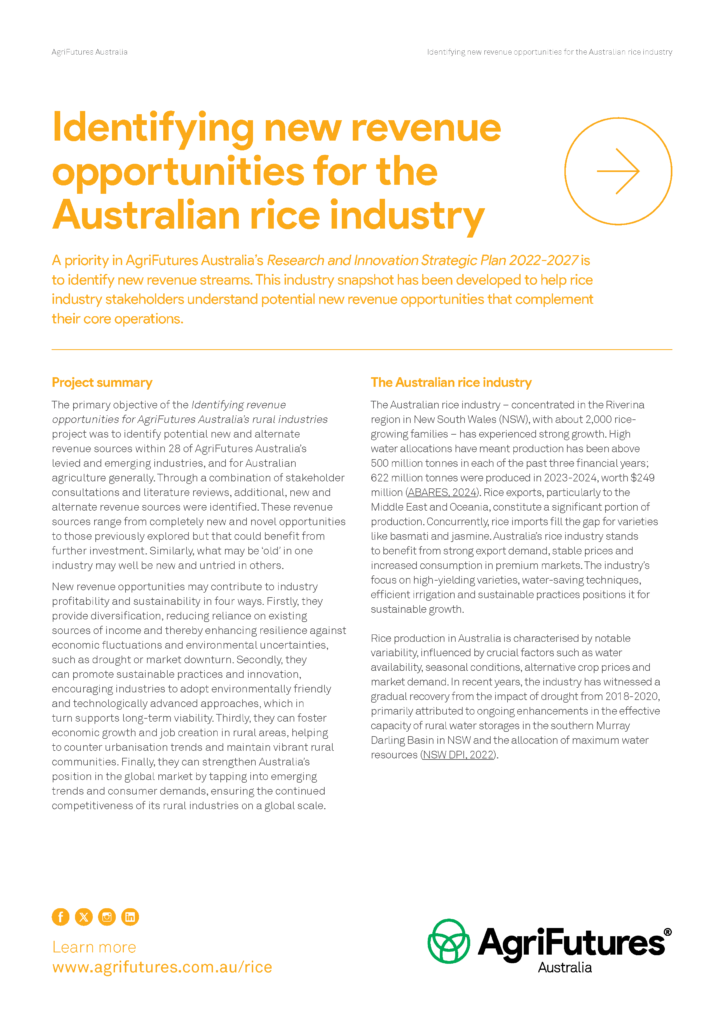Rice Extension Annual Summary CY25
This report acts as a detailed snapshot of the season, guidebook for rice growers, a reference guide for researchers and an educational resource for other...
 RICE
RICE 
2 pages
Published: 11 Oct 2024
Author(s): AgriFutures Australia
Download report PDF
DownloadThe primary objective of the Identifying revenue opportunities for AgriFutures Australia’s rural industries project was to identify potential new and alternate revenue sources within 28 of AgriFutures Australia’s levied and emerging industries, and for Australian agriculture generally. Through a combination of stakeholder consultations and literature reviews, additional, new and alternate revenue sources were identified. These revenue sources range from completely new and novel opportunities to those previously explored but that could benefit from further investment. Similarly, what may be ‘old’ in one industry may well be new and untried in others.
New revenue opportunities may contribute to industry profitability and sustainability in four ways. Firstly, they provide diversification, reducing reliance on existing sources of income and thereby enhancing resilience against economic fluctuations and environmental uncertainties, such as drought or market downturn. Secondly, they can promote sustainable practices and innovation, encouraging industries to adopt environmentally friendly and technologically advanced approaches, which in turn supports long-term viability. Thirdly, they can foster economic growth and job creation in rural areas, helping to counter urbanisation trends and maintain vibrant rural communities. Finally, they can strengthen Australia’s position in the global market by tapping into emerging trends and consumer demands, ensuring the continued competitiveness of its rural industries on a global scale.
Industry-specific challenges
Specific insights relating to the Australian rice industry include:
1. Water availability poses the most significant challenge for the industry. Rice is a highly water-dependent crop, relying on both rainfall and general security irrigation water, which have become increasingly unreliable over the years.
2. Resource challenges, including rising fertiliser prices, adoption of technologies and skilled labour shortages, are potentially impacting industry growth. Additionally, the industry must address communities’ increasing sustainability and environmental concerns.
3. The use of high-quality rice seeds is crucial for achieving a successful crop. To maintain rice quality, it is vital to maintain and further implement a pure seed production program.
Industry-specific opportunities
Specific opportunities relating to the Australian rice industry include:
1. Stimulating domestic consumption of Australian rice through consumer education on its quality and sustainability, developing rice-based products tailored to consumer preferences, and forging partnerships with food manufacturers, retailers and restaurants. Additionally, diversifying the range of rice-based products, such as gluten-free options, rice flour and convenient on-the-go products, to cater to evolving consumer preferences.
2. Continuing to invest in breeding new rice varieties to expand the industry’s geographical footprint. Differentiating Australian rice in the global marketplace, capitalising on our reputation for producing high-quality agricultural products, will benefit the industry.
3. Utilising rice stubble for bioenergy production, paper and pulp, building materials and other innovative applications can enhance revenue and environmental sustainability.